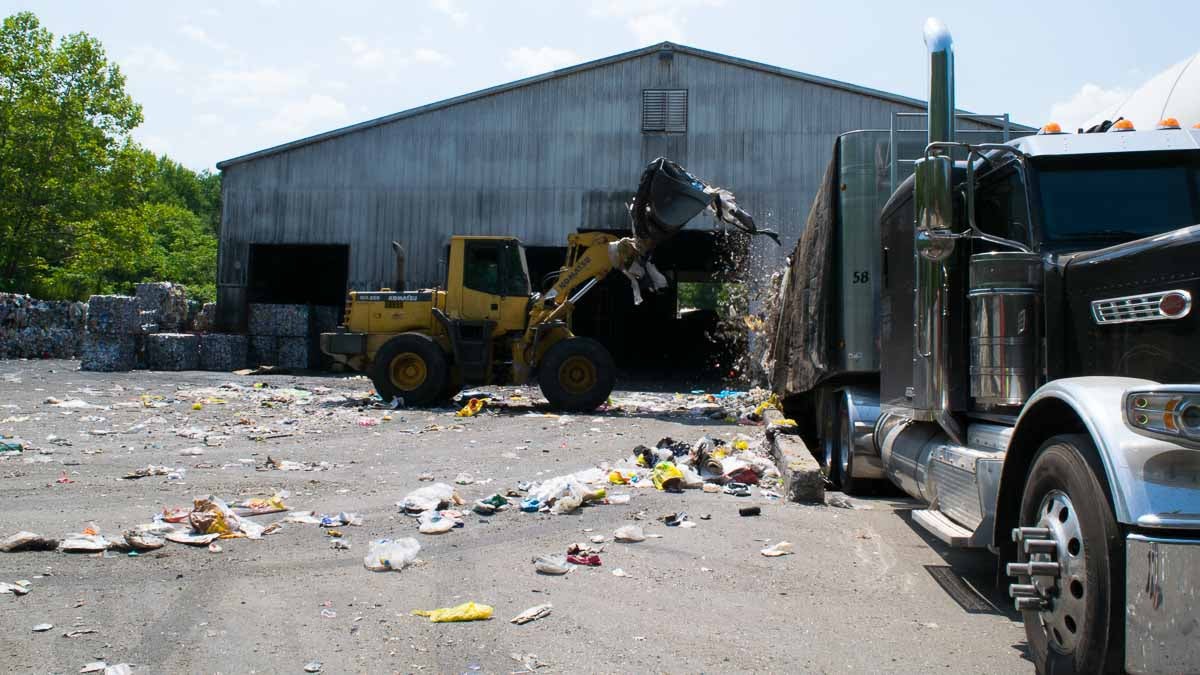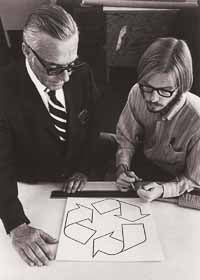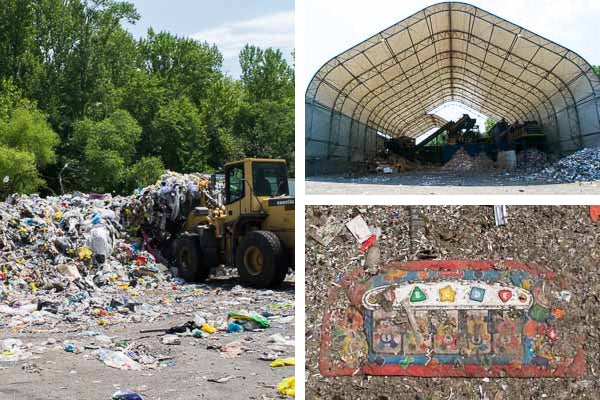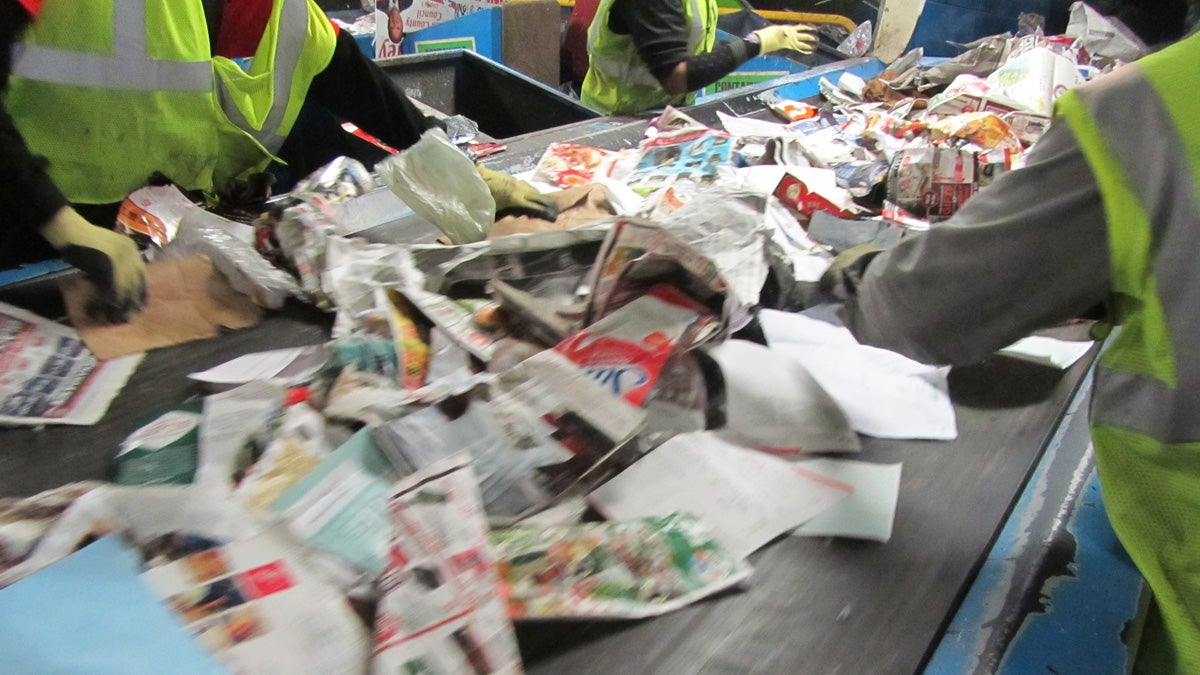How one symbol has led to truckloads of trash and confusion
Listen
A front loader scoops up trash that has accumulated at the Omni Recycling Plant in Pitman
It was 1970 when Gary Anderson, a 23-year-old architecture student at the University of Southern California, saw a poster for a design competition. The task was to design a symbol for recycling in honor of the first Earth Day in 1970.
The symbol was supposed to represent paper and cardboard recycling only, and Anderson was inspired by a trip to a printing press.
“It was that dynamic movement of paper around cylinders going up and down and back and forward that inspired that symbol,” he says.
His symbol was simple: three curved arrows chasing one another in a triangular shape. If it sounds familiar, that’s because it’s on packaging and recycling bins around the world.
 But a lot has changed in recycling since Anderson won that design competition for his chasing arrow symbol. Recycling isn’t just for paper and cardboard — now we recycle various types of plastic, aluminum and glass. And that symbol can mean a few different things, as well — an item with the symbol may be made from recycled material, or it may be recyclable.
But a lot has changed in recycling since Anderson won that design competition for his chasing arrow symbol. Recycling isn’t just for paper and cardboard — now we recycle various types of plastic, aluminum and glass. And that symbol can mean a few different things, as well — an item with the symbol may be made from recycled material, or it may be recyclable.
“I think it’s expecting an awful lot of the recycling symbol, or any other logo for that matter, to represent a myriad of concepts. It’s just not what the job of logos is,” Anderson says.
Regardless of those complications, the symbol has remained the same, and some experts believe it may not be enough anymore.
Confusion turns into trash
Everyone knows how it feels to walk up to a recycling bin with a bottle or can in hand and hesitate, thinking “can I really recycle this?” More often than not, we toss it in the bin and don’t give it a second thought. And if that item wasn’t recyclable, we don’t usually get to see the effect it has once it gets to the recycling plant.
But Kevin Carducci, plant manager at Omni Recycling in Pitman, New Jersey, does get to see what happens. While it might not seem like a big deal for you to accidentally put one item of trash in your recycling, imagine if everyone on your block, everyone in your neighborhood, and everyone in your city does, too.
“It’s disgusting,” Carducci says, gesturing at a pile of trash at the plant. “Tarps, seat cushions, car parts, mattresses…that shouldn’t be coming to anybody’s facility for single stream.”
Carducci walks up a set of stairs into the heart of the recycling plant. It looks like a game of shoots and ladders gone wrong — sets of stairs going off in every direction, conveyor belts pushing around bottles, paper, cardboard and cans. The noise is deafening, and it reeks. It reeks like hot, smelly trash. And that’s because there is trash everywhere.
“This is all the trash that they have cleared off the line out of the single stream since 7 a.m. this morning,” Carducci says, leaning over a railing and pointing at a pile of garbage the size of a small hill accumulating on the ground below us. “That’s probably five or six tons of trash they’ve already pulled out of the line.
Five or six tons and it was only 11 a.m. He estimates that his crew pulls 150 tons of garbage out of the stream of recyclables every single week. To put that in perspective, that’s the weight of about 18 elephants.
For every ton of trash, Carducci has to pay $100 to get a semi-truck to come pick it up and drop it off at a landfill. The grand total comes to about $15,000 per week. That cost, combined with increasing international competition from other recycling plants, and the ever-changing marketplace for recyclables, is really hurting these businesses.

Left, a front loader plows into a pile of garbage to load it into a semi truck, which will take it to a landfill. Top right, Omni Recycling Center in Pitman, New Jersey. Bottom right, a children’s toy flattened to the ground of the recycling plant along with other garbage and debris. (Paige Pfleger/WHYY)
Embracing complication
Recycling can’t be summed up with one symbol anymore, and other countries are embracing a move away from simplicity and seeing a lot of success.
Germany’s system is complicated — they heavily pre-sort all of their items, down to the color of the glass. They launched a public education initiative to teach people how to sort properly, and now, Germans are the top recyclers in the world. They recycle 65 percent of their waste.
South Korea has a variation on Anderson’s symbol but it’s color coded — orange means glass, gray means cans. And their residents have to pay based on the amount of waste left over. They recycle 59 percent of their waste.
A non-profit called Recycle Across America is trying to bring that success back to the U.S.:
“Introduce a standardized labeling system for recycling bins,” says Mitch Hedlund, executive director of the non-profit.
The labels are color-coded by material, and have the chasing arrow symbol along with the name of what can be recycled, a short description, and a picture of the different items. The National Park Service is trying out the labels, and so is the state of Rhode Island. If they see an improvement, other states might adopt the labels too.
Standardizing these labels, Hedlund explains, could be the start to making recycling less confusing.
“If you see a recycling bin that has a chasing arrow on it, and that’s the only information that’s on the recycling bin, that’s not enough information for the consumer to know if that packaging that also has a chasing arrow, can go in that bin,” she says.
Regardless of which solution might be best, Kevin Carducci at the recycling plant in New Jersey is just glad that people are putting some thought into the confusion surrounding recycling.
“We’ve had deer in the facility, that were dead or whatever, somebody hunted them and the head comes up the line and we have to pull it off. It gets clogged in the machinery, and we have to cut it out,” Carducci says. “Why would you even do that? It’s just bad news.”
Bad news, and insult upon injury for an industry that is trying to stay afloat, despite the complications.

Kevin Carducci holds a blade from a lawnmower — someone put it in with their recycling, and it got lodged in the machinery of the plant, shutting it down for several minutes. (Paige Pfleger/WHYY)
WHYY is your source for fact-based, in-depth journalism and information. As a nonprofit organization, we rely on financial support from readers like you. Please give today.



